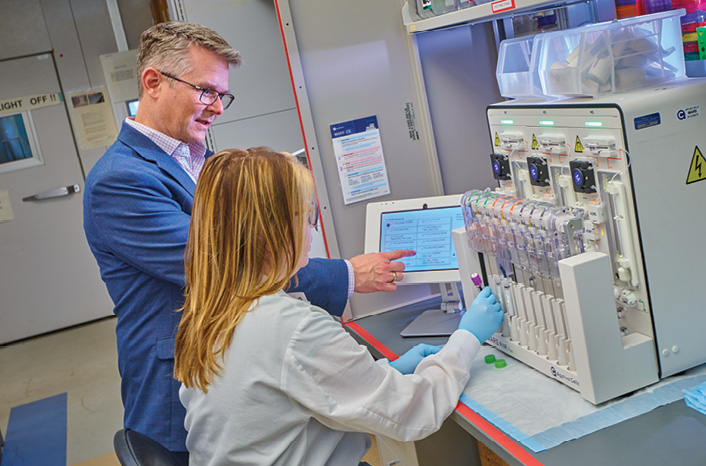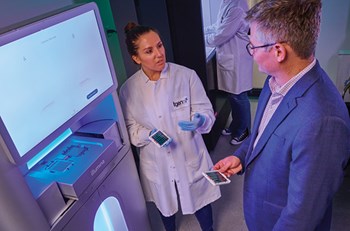
TGen’s Collaborative Sequencing Center is continually upgrading its equipment and software to provide the most efficient, accurate and inexpensive next-generation sequencing.

An outbreak of bird flu became the catalyst that turned Jonathan Keats, Ph.D., toward a career in cancer research. The Ph.D. advisor he wanted to study with at the time had gone to Hong Kong to investigate the outbreak, leaving Keats time to ponder whether he really wanted to dedicate his life to flu research. The answer came back no. Instead, Keats shifted his focus to genetic research on cancers, but he was determined to work directly with biopsies from patients, rather than just using mice or isolated cell lines in the lab. “I didn’t want to be someone who conducted research that might help people in 20 years. I wanted to make an immediate impact,” he says. He also notes that this is why he enjoys working at TGen, as they share the same ethos: “Help someone today” he adds. “That’s definitely a TGen motto.”
Illuminating the “Dark” Parts of the Genome
Today, Keats is an assistant professor in TGen’s Integrated Cancer Genomics Division and directs TGen’s Collaborative Sequencing Center (CSC), a service center that provides next-generation sequencing for researchers around the world. Curious about the collection of genetic mutations within a patient’s tumor? Want to sequence a child’s entire genome and compare it with the whole genomes of her parents to find the cause of a rare disease? Hope to take a closer look at how RNA influences gene expression in a single cell? The CSC can help. The state-of-the-art center draws on an array of advanced machines and analysis platforms to perform next-generation sequencing. Next-generation sequencing uncovers the genetic sequence of a patient’s sample by sequencing billions of gene fragments at once, instead of determining the sequence one section of the genome at a time. The center is continually upgrading its equipment and software to provide the most efficient, accurate and inexpensive next-generation sequencing, “so that the questions we want to ask can be addressed with the best technology we have today,” Keats says. There are different ways of sorting through the secrets of a genome, each with its own bespoke technology, he explains. There’s short-read sequencing, which gives a highly accurate readout of 50 to 300 “letters” or base pairs in a piece of DNA. TGen has been a leader in pushing short-read data into the clinic, using it to detect the “needle in a haystack” mutation that could affect a patient’s response to therapy or determine whether a cancer patient has no detectable mutation after treatment. This spring, the center installed its first long-read sequencer, the Oxford PromethION, which allows researchers to sequence a much longer string of DNA, up to the megabase or million base pair-long segments. The longer read allows a better glimpse at the DNA surrounding an interesting part of the genome but is less accurate than short reads. Along with DNA sequence data, the long read can also identify modifications to genes that change their expression—a phenomenon called epigenetics. If a clinician is wondering why a patient stops responding to a particular cancer therapy, the long read can provide an answer as to whether the therapy has deleted the targeted gene or modified it in a way that prevents its expression. “It’s nice to be able to do all that in one test,” Keats notes. In September, the center added another sequencer that looks at intermediate length DNA. “It breaks DNA into pieces of about 20,000 base pairs and makes a circle of it, and then the sequencer goes around and around and reads the circle over and over again,” explains Keats, “giving us the kind of accuracy that we can get from a short-read sequencer.” Back in 2001, the first draft human genome sequence was assembled for about $3 billion and had numerous gaps in its data. Today, “our two new instruments together let us do human genome assemblies that are gapless for less than $10,000,” Keats notes. The new platforms shine light on the “dark regions of the human genome,” he says. “We can now diagnose diseases in a patient that we couldn’t before because we now realize that the genetic error in this patient is in a piece of DNA that we didn’t even appreciate exists in the human species.” Cancer sometimes occurs by what Keats calls “structural events”—occurrences that involve the deletion, repetition, flipping end to end, or swapping of a piece of DNA between chromosomes. Short-read sequencing doesn’t always pick up on these events, he says. For 15 years, Keats worked on cells from a cancer patient trying to figure out why his cells appeared as they did. “And then this summer we did long-read sequencing and all of the sudden it made perfect sense.” “Before we weren’t seeing what we thought we should be seeing, because there … happened to be two structural events side by side,” he explains. “The short-read sequencing would only show us one but never showed us the second one.” The solution presented itself with the help of a new sequencer and work done in part by a Helios Scholar summer intern, Keats says. “I think that’s what makes me excited, because I know when we apply these sequencers to patient material, it’ll help us understand things we haven’t before.”
A Research Unicorn
Keats is also the Scientific Director of the Judy and Bernard Briskin Center for Multiple Myeloma Research at City of Hope. A relatively rare cancer—about 0.8 percent of Americans will get the disease in their lifetime—multiple myeloma occurs in plasma cells in the bone marrow, where the affected cells appear under the microscope like a malevolent batch of sunny-side up eggs. When Keats turned from influenza to cancer research, he began working with a former professor who happened to study myeloma. “And now I realize how lucky I was, because it’s a unicorn disease when it comes to genetic research and research in general,” he says. Researchers studying the genetics of cancers like breast cancer, for instance, analyze patient samples that sometimes only contain about 50 percent tumor material, Keats notes. It’s standard practice in multiple myeloma to enrich the material taken from a patient’s bone marrow, however, “so every sample I work on is about 95 percent tumor content or greater.” With such pure material at hand, scientists can explore genetic aspects of cancer that have been difficult to confirm. For instance, Keats and his colleagues have learned that RNA measurements in a tumor are highly reproducible across studies and over time—something that was very difficult to see in solid tumors. “I do think myeloma is sending a strong signal that if you can get rid of the contaminating normal that just adds noise to the system, that we will be able to learn a lot more about your disease,” he says. And since plasma cells secrete certain antibodies, scientists can use the antibodies produced by myeloma cells as a kind of natural biomarker. “You can basically track the amount of that antibody in the blood and that reflects the mass of tumor that exists in the body,” Keats explains. “We can readily monitor outcomes with a simple blood test.” TGen scientists, among others in the cancer community, have long worked toward this goal of a simple way of monitoring tumors and how they respond to treatment. “But we’ve been doing this in myeloma for decades,” Keats says. Keats is the lead researcher on the Multiple Myeloma Research Foundation’s Clinical Outcomes in Multiple Myeloma to Personal Assessment of Genetic Profile (CoMMpass) study, the largest single sequencing study of newly diagnosed multiple myeloma patients to date. CoMMpass confirmed that there are two main groups of myeloma patients: one group with extra copies of chromosomes in their tumor cells, and another group with specific rearrangements in their chromosomes. But the researchers have also uncovered multiple subtypes within these two groups, each with its own genetic quirks. These subtypes and specific genetic events help clinicians choose the therapy that best targets a patient’s tumor—and avoid costly, time-consuming therapies that don’t match—as Keats and his colleagues reported recently in a study published in Nature Medicine.
Answers in 48 Hours